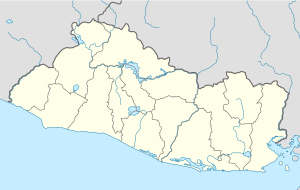San Francisco Gotera
| San Francisco Gotera | ||
|---|---|---|
|
Coordinates: 13 ° 42 ′ N , 88 ° 6 ′ W San Francisco Gotera on the map of El Salvador
|
||
| Basic data | ||
| Country | El Salvador | |
| Department | Morazan | |
| City foundation | July 8, 1875 | |
| Residents | 21,049 (2012) | |
| City insignia | ||
| Detailed data | ||
| surface | 59.76 km² | |
| Population density | 350 people / km 2 | |
| height | 301 m | |
| City structure | 6 cantons | |
| Waters | Río Grande de San Miguel | |
| Website | ||
San Francisco Gotera is a municipality and at the same time the capital of the Morazán department in El Salvador . The Río Grande de San Miguel flows through the city . It is located at an altitude of 301 m and 169 km east of the Salvadoran capital San Salvador . The city has an area of 59.76 km² and is divided into 6 cantons with a total of 21,049 inhabitants.
history
Civil war
During the first three years of El Salvador's civil war, the city's population almost tripled due to displaced people fleeing the north of the country. Most of the refugees came from the municipalities of Torola , San Fernando , Perquín , Arambala , Joateca , Jocoaitique , El Rosario , and Meanguera .
During the war, part of the park in San Francisco Gotera was turned into a military base and the other part was paved over. After the war, the base was unused for a few years and was finally converted into an urban market in 2002. However, this place is almost empty today, as another covered market with running water was opened in 2003.
Surname
The word Gotera is a native word that is made up of two other words: Got , which means something like snake and Era , which means hill. So gotera means something like hill of serpents . The original population of Gotera lived on the top of a hill called Coroban, where remains of the earlier settlement are repeatedly found. The present city was named after the community called San Francisco and was called San Francisco Gotera from that point on . Many locals also simply call the city Gotera .
economy
Until the 1980s, the city lived from the intensive trade in agricultural and handicraft products, such as ropes made from Cyprus grass . In recent years the economy has been shaped more by the processing of synthetic materials.
sons and daughters of the town
- Juan José Guzmán (1797–1847), President of El Salvador from 1842 to 1844.


